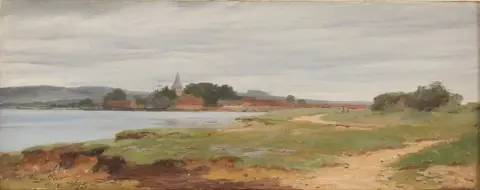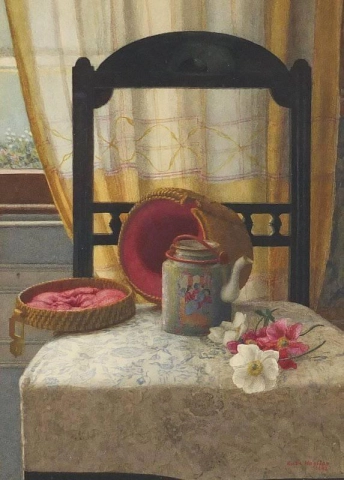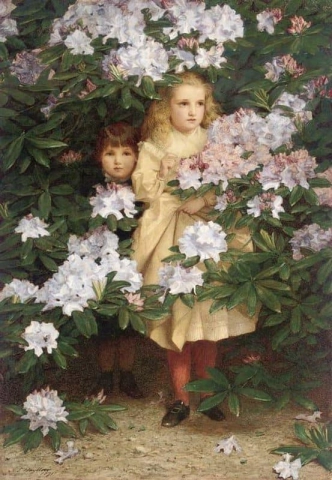

Hand painted reproductions of Edith Hayllar
Edith Hayllar: Capturing the Elegance of Victorian Society
Edith Hayllar (1860–1948) was an English painter renowned for her delicate and intricate depictions of Victorian society, particularly focusing on portraits, genre scenes, and the lives of women in the late 19th century. Known for her ability to capture the refined elegance and inner worlds of her subjects, Hayllar's work stands as a testament to the beauty and complexity of the period.
Early Life and Education
Edith Hayllar was born in 1860 in England into an artistic family. Her father, Henry Hayllar, was a genre painter who had trained at the Royal Academy, and his influence would prove significant in shaping Edith's early artistic development. Growing up in a household surrounded by art, Edith demonstrated a natural inclination toward painting from a young age.
Hayllar’s formal art education began when she attended the Slade School of Fine Art in London, one of the most prestigious art schools in Britain at the time. At the Slade, she received rigorous training in the academic traditions of drawing and painting, which equipped her with the technical skills that would serve her throughout her career. Her studies at the Slade were essential in refining her observational skills and ability to capture the subtle nuances of human expression and the textures of fabric and light.
Artistic Development and Style
Edith Hayllar’s early work was largely influenced by the Pre-Raphaelite and Aesthetic movements, both of which sought to revive the intricate detail and vivid color found in medieval and Renaissance art. Hayllar was particularly drawn to the work of the Pre-Raphaelite Brotherhood, whose emphasis on detailed naturalism and the portrayal of women in an idealized, romantic light inspired many of her genre scenes and portraits.
Although she was not formally a member of the Pre-Raphaelite group, Hayllar’s style and subject matter were closely aligned with their ideals. Her works often featured young women in elegant, fashionable clothing, set in domestic interiors, gardens, or other tranquil settings. Hayllar’s compositions were characterized by their intricate detail, particularly in the rendering of fabrics, flowers, and textures, which gave her paintings a highly decorative and almost ethereal quality.
Her approach to color was also distinctive, employing a soft, muted palette with pastel hues to convey a sense of grace and refinement. She paid close attention to the emotional depth of her subjects, often capturing moments of quiet contemplation or interaction between women. This attention to the inner world of her subjects gave her work a psychological complexity that set it apart from other genre scenes of the period.
Themes and Significance
One of the defining characteristics of Edith Hayllar’s work is her focus on women and the domestic sphere. Throughout her career, she painted numerous scenes depicting women engaged in leisure activities, such as reading, sewing, or enjoying tea. These works reflect the social norms of the Victorian era, where women were often confined to the private realm of the home. However, Hayllar’s portrayal of these domestic moments is never mundane or trivial; instead, her subjects are imbued with a quiet dignity and grace, offering a glimpse into the interior lives of women during a time of rigid social expectations.
Hayllar's paintings often depicted women in groups, creating intimate domestic scenes that conveyed the camaraderie and support shared among women. This focus on female relationships was particularly significant, as it offered an alternative to the more traditional portrayals of women in isolated or romantic settings. Her works emphasized the richness of female experience, particularly in the context of the home and social gatherings, reflecting the complex roles that women played within their families and communities.
In addition to genre scenes, Hayllar also painted a number of portraits, where she excelled in capturing the character and personality of her sitters. Her portraits were celebrated for their precision and sensitivity, particularly in their depiction of the faces and clothing of her subjects. Hayllar’s portraits often combined elements of realism with a refined, almost idealized presentation, further emphasizing her subjects' dignity and inner beauty.
Achievements and Recognition
Edith Hayllar’s work gained recognition within the British art community during her lifetime. She exhibited her paintings at prominent venues, including the Royal Academy, and was also a member of the prestigious Society of Women Artists. Although she was not one of the most widely known artists of the time, her work was appreciated for its refined elegance and technical skill.
One of her best-known works is “The Drawing Room”, an intimate portrayal of women engaged in domestic activities, which exemplifies her mastery of light, texture, and composition. Hayllar’s ability to render the tactile qualities of fabric, the softness of skin, and the richness of interior spaces earned her respect among her peers.
Her works are now held in several important collections, and she is regarded as a key figure in the movement that sought to capture the beauty and intricacy of domestic life during the late 19th century. Her works remain valuable not only for their technical prowess but also for their portrayal of women’s lives and experiences during the Victorian era.
Legacy
Edith Hayllar’s legacy is one of understated elegance and emotional depth. Although her name may not be as widely recognized as some of her contemporaries, her work continues to be appreciated for its intimate portrayal of women’s lives, its decorative beauty, and its contribution to the genre of Victorian domestic art. Her paintings offer a rare and valuable insight into the social dynamics of the period, particularly the roles and experiences of women in a time of social constraint.
Today, Hayllar’s work is held in several public and private collections, including the Walker Art Gallery in Liverpool and the Manchester Art Gallery, and is often featured in exhibitions focused on the Pre-Raphaelite and Victorian art movements.
Where to Find Reproductions of Edith Hayllar’s Art
For collectors and enthusiasts of Victorian art, high-quality reproductions of Edith Hayllar’s paintings offer the opportunity to bring her delicate and intricate depictions of female figures into contemporary spaces. These reproductions capture the artist’s nuanced use of light, texture, and color, offering a timeless reflection of Victorian femininity and domestic life.
Imagine owning an original-style painting by one of the greatest artists in history. At POD, we offer you the chance to make this dream a reality. Each canvas is faithfully reproduced down to the smallest detail, allowing you to experience the beauty of the artist’s vision in your own home.
Our reproductions are crafted by experienced painters using the finest materials and time-honored methods. We are committed to delivering works of exceptional quality that will inspire and bring joy to your family for generations to come.





















































